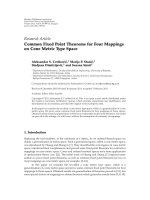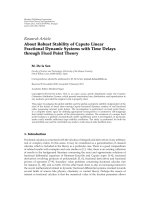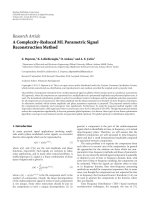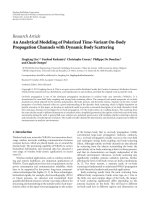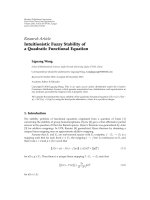Báo cáo hóa học: " Research Article Approximating Fixed Points of Nonexpansive Mappings in Hyperspaces" pptx
Bạn đang xem bản rút gọn của tài liệu. Xem và tải ngay bản đầy đủ của tài liệu tại đây (491.91 KB, 9 trang )
Hindawi Publishing Corporation
Fixed Point Theory and Applications
Volume 2007, Article ID 50596, 9 pages
doi:10.1155/2007/50596
Research Article
Approximating Fixed Points of Nonexpansive
Mappings in Hyperspaces
Zeqing Liu, Chi Feng, Shin Min Kang, and Jeong Sheok Ume
Received 29 March 2007; Revised 27 August 2007; Accepted 13 September 2007
Recommended by Wataru Takahashi
Two convergence theorems for the Ishikawa and Mann iteration sequences involving
nonexpansive mappings in hyperspaces are established.
Copyright © 2007 Zeqing Liu et al. This is an open access article distributed under the
Creative Commons Attribution License, which permits unrestricted use, distribution,
and reproduction in any medium, provided the original work is properly cited.
1. Introduction and preliminaries
Let X be a nonempty compact subset of a Banach space (E,
·), and let C(X)andCC(X)
denote the families of all nonempty compact and all nonempty compact convex subsets
of X, respectively. It is well known that (C(X),H)iscompact,whereH is the Hausdorff
metric induced by
·.ForA,B ∈ CC( X)andt ∈ R
=
(−∞,+∞), let A + B ={a + b :
a
∈ A, b ∈ B},andlettA ={ta : a ∈ A}. In the sequel, we assume that X is a nonempty
compactconvexsubsetofE. Hu and Huang [1]provedthat(CC(X),H)isacompact
subset of (C(X),H). It is clear that tA +(1
− t)B ∈ CC(X)forallA,B ∈ CC(X)andt ∈
[0,1]. That is, CC(X) has convexity structure. Let I be a nonempty subset of CC(X).
AmappingT :(
I,H)→(I,H)issaidtobenonexpansive if H(TA, TB) ≤ H(A,B)forall
A,B
∈ I.
Within the past 20 years or so, a few researchers have applied the Mann iteration
method and the Ishikawa iteration method to approximate fixed points of nonexpansive
mappings in several classes of subsets of Banach spaces. For details we refer to [2–11].
Recently, Hu and Huang [1] established the following result.
Theorem 1.1. Let X be a nonempty compact convex subset of a Banach space (E,
·),and
let
I be a nonempty compact convex subset of CC(X).SupposethatT :(I,H)→(I,H) is
nonexpansive. Then for any A
0
∈ I,thesequencedefinedby
2 Fixed Point Theory and Applications
A
n
= 2
−1
A
n−1
+ TA
n−1
, n ≥ 1, (1.1)
converges to a fixed point of T.
Inspired and motivated by the results in [1–11], in this paper we int roduce the con-
cepts of the Mann and Ishikawa iteration sequences in hyperspaces, and establish the con-
vergence theorems for the Mann and Ishikawa iteration sequences dealing with nonex-
pansive mappings in hyperspaces. The results in this paper extend substantially Theorem
1.1.
In order to prove our results, we need the following concepts and results.
Definit ion 1.2. Let
I be a nonempty compact convex subset of CC(X), and let T :(I, H)→
(I,H)beamapping.
(1) For any A
0
∈ I, the sequence {A
n
}
n≥0
⊆ I defined by
B
n
=
1 − s
n
A
n
+ s
n
TA
n
, n ≥ 0,
A
n+1
=
1 − t
n
A
n
+ t
n
TB
n
, n ≥ 0,
(1.2)
is called the Ishikawa iteration sequence,where
{t
n
}
n≥0
and {s
n
}
n≥0
are real sequences in
[0,1] satisfying appropriate conditions.
(2) If s
n
= 0foralln ≥ 0in(1.2), the sequence {A
n
}
n≥0
⊆ I defined by
A
n+1
=
1 − t
n
A
n
+ t
n
TA
n
, n ≥ 0, (1.3)
is called the Mann iteration sequence.
(3) If s
n
= 0andt
n
= 1foralln ≥ 0in(1.2), the sequence {A
n
}
n≥0
⊆ I defined by
A
n+1
= TA
n
, n ≥ 0, (1.4)
is called the Picard iteration sequence.
Lemma 1.3. Let A, B, U,andV be in CC(X),andlett be in [0,1]. Then
H
tA+(1− t)B,tU +(1− t)V
≤
tH(A,U)+(1− t)H(B,V). (1.5)
Proof. Put r
= tH(A,U)+(1− t)H(B,V ). For any a ∈ A and b ∈ B,byNadler’sresultwe
know that there exist u
∈ U, v ∈ V such that a − u≤H(A,U)andb − v≤H(B,V)
which yield that
ta+(1− t)b − tu− (1 − t)v
≤
ta − u +(1− t)b − v≤r. (1.6)
Zeqing Liu et al. 3
It follows that
sup
a∈A,b∈B
inf
u∈U,v∈V
ta+(1− t)b − tu− (1 − t)v
≤
r. (1.7)
Similarly, we have
sup
u∈U,v∈V
inf
a∈A,b∈B
ta+(1− t)b − tu− (1 − t)v
≤
r. (1.8)
Consequently, we infer that
H
tA+(1− t)B,tU +(1− t)V
=
max
sup
a∈A,b∈B
inf
u∈U,v∈V
ta+(1− t)b − tu− (1 − t)v
,
sup
u∈U,v∈V
inf
a∈A,b∈B
ta+(1− t)b − tu− (1 − t)v
≤
r.
(1.9)
This completes the proof.
Lemma 1.4 [9]. Suppose that {a
n
}
n≥0
and {b
n
}
n≥0
are two sequences of nonnegative num-
bers such that a
n+1
≤ a
n
+ b
n
for all n ≥ 0.If
∞
n=0
b
n
converges, then lim
n→∞
a
n
exists.
2. Main results
Now we prove the following results.
Theorem 2.1. Let X be a nonempty compact convex subset of a Banach space (E,
·),and
let
I be a nonempty compact convex subset of CC(X).SupposethatT :(I,H)→(I,H) is
nonexpansive and there exist constants a and b satisfying that
0 <a
≤ t
n
≤ b<1, 0 ≤ s
n
≤ 1, n ≥ 0, (2.1)
∞
n=0
s
n
< ∞. (2.2)
Then for any A
0
∈ I, the Ishikawa iteration sequence {A
n
}
n≥0
convergestoafixedpointofT.
Proof. Let n and k be arbitrary nonnegative integers. Note that tA+(1
− t)A = A for any
A
∈ CC(X)andt ∈ [0,1]. Using (1.2), Lemma 1.3 and the nonexpansiveness of T,we
infer that
H
TB
n
,A
n
≤
H
TB
n
,TA
n
+ H
TA
n
,A
n
≤
H
B
n
,A
n
+ H
TA
n
,A
n
≤
1+s
n
H
A
n
,TA
n
,
(2.3)
4 Fixed Point Theory and Applications
and that
H
A
n+1
,A
n
≤
t
n
H
TB
n
,A
n
≤
t
n
1+s
n
H
A
n
,TA
n
. (2.4)
By virtue of (1.2), (2.3), (2.4), Lemma 1.3, and the nonexpansiveness of T,wegetthat
H
B
n
,A
n+k+1
≤
H
B
n
,A
n+1
+
k
i=1
H
A
n+i
,A
n+i+1
≤
1 − s
n
H
A
n
,A
n+1
+ s
n
H
TA
n
,A
n+1
+
k
i=1
t
n+i
1+s
n+i
H
A
n+i
,TA
n+i
≤
1 − s
2
n
t
n
H
A
n
,TA
n
+ s
n
1 − t
n
H
A
n
,TA
n
+ t
n
H
TB
n
,TA
n
+
k
i=1
t
n+i
+ s
n+i
H
A
n+i
,TA
n+i
≤
t
n
+ s
n
1 − t
n
H
A
n
,TA
n
+
k
i=1
t
n+i
+ s
n+i
H
A
n+i
,TA
n+i
≤
k
i=0
t
n+i
+ s
n+i
H
A
n+i
,TA
n+i
,
(2.5)
and that
H
TA
n+1
,A
n+1
≤
1 − t
n
H
A
n
,TA
n+1
+ t
n
H
TB
n
,TA
n+1
≤
1 − t
n
H
A
n+1
,TA
n+1
+ H
A
n+1
,A
n
+ t
n
H
B
n
,A
n+1
≤
1 − t
n
H
A
n+1
,TA
n+1
+
1 − t
n
t
n
1+s
n
H
A
n
,TA
n
+ t
n
1 − t
n
H
A
n
,B
n
+ t
n
H
TB
n
,B
n
,
(2.6)
which together with (2.1) implies that
H
A
n+1
,TA
n+1
≤
1 − t
n
1+s
n
H
A
n
,TA
n
+
1 − t
n
H
A
n
,B
n
+ t
n
H
TB
n
,B
n
≤
1 − t
n
1+2s
n
H
A
n
,TA
n
+ t
n
1 − s
n
H
A
n
,TB
n
+ s
n
H
TA
n
,TB
n
≤
1+2s
n
1 − t
n
H
A
n
,TA
n
≤
1+2
1 − a
s
n
H
A
n
,TA
n
.
(2.7)
Zeqing Liu et al. 5
Notice that the compactness of
I implies that {H(A
n
,TA
k
):n ≥ 0, k ≥ 0} is bounded. It
follows from Lemma 1.4,(2.2), and (2.7)that
lim
n→∞
H
A
n
,TA
n
=
r ≥ 0, (2.8)
which implies that for any ε>0 there exists a positive integer N such that
r
− ε ≤ H
A
n
,TA
n
≤
r + ε, n ≥ N. (2.9)
It follows that
H
A
n+1
,TC
≤
1 − t
n
H
A
n
,TC
+ t
n
H
TB
n
,TC
≤
1 − t
n
H
A
n
,TC
+ t
n
H
B
n
,C
, C ∈ I, n ≥ 0,
(2.10)
which yields that
H
A
n
,TC
≥
1 − t
n
−1
H
A
n+1
,TC
−
t
n
H
B
n
,C
, C ∈ I, n ≥ 0. (2.11)
Now we prove by induction that t he following inequality holds for all n
≥ 1:
H
A
p
,TA
p+n
≥
(r + ε)
1+
n−1
i=0
t
p+i
−
2ε
n−1
i=0
1 − t
p+i
−1
− (r + ε)
n−1
i=0
t
p+i
n−1
j=i
s
p+ j
i
k=0
1 − t
p+k
−1
, p ≥ N.
(2.12)
Using (2.5), (2.9), and (2.11), we obtain that
H
A
p
,TA
p+1
≥
1 − t
p
−1
H
A
p+1
,TA
p+1
−
t
p
H
B
p
,A
p+1
≥
1 − t
p
−1
r − ε − (r + ε)t
p
t
p
+ s
p
=
1 − t
p
−1
r − ε − (r + ε)
1 − 2
1 − t
p
+
1 − t
p
2
+ t
p
s
p
=
(r + ε)
1+t
p
−
2ε
1 − t
p
−1
− (r + ε)t
p
s
p
1 − t
p
−1
, p ≥ N.
(2.13)
Hence (2.12)holdsforn
= 1. Suppose that (2.12)holdsforn = m ≥ 1. That is,
H
A
p
,TA
p+m
≥
(r + ε)
1+
m−1
i=0
t
p+i
− 2ε
m−1
i=0
1 − t
p+i
−1
− (r + ε)
m−1
i=0
t
p+i
m−1
j=i
s
p+ j
i
k=0
1 − t
p+k
−1
, p ≥ N.
(2.14)
6 Fixed Point Theory and Applications
According to (2.5), (2.9), (2.11), and (2.14), we infer that
H
A
p
,TA
p+m+1
≥
1 − t
p
−1
H
A
p+1
,TA
p+m+1
−
t
p
H
B
p
,A
p+m+1
≥
1 − t
p
−1
(r + ε)
1+
m−1
i=0
t
p+1+i
−
2ε
m−1
i=0
1 − t
p+1+i
−1
− (r + ε)
m−1
i=0
t
p+1+i
m−1
j=i
s
p+1+ j
i
k=0
1 − t
p+1+k
−1
−
(r + ε)t
p
m
i=0
t
p+i
+ s
p+i
=
(r + ε)
1 − t
p
−1
1+
m−1
i=0
t
p+1+i
−
t
2
p
+ t
p
m
i=1
t
p+i
+ t
p
m
i=0
s
p+i
−
2ε
m
i=0
1 − t
p+i
−1
− (r + ε)
1 − t
p
−1
m
−1
i=0
t
p+1+i
m−1
j=i
s
p+1+ j
i
k=0
1 − t
p+1+k
−1
=
(r + ε)
1+
m
i=0
t
p+i
−
(r + ε)
1 − t
p
−1
t
p
m
i=0
s
p+i
− 2ε
m
i=0
1 − t
p+i
−1
− (r + ε)
m
i=1
t
p+i
m
j=i
s
p+ j
i
k=0
1 − t
p+k
−1
=
(r + ε)
1+
m
i=0
t
p+i
−
2ε
m
i=0
1 − t
p+i
−1
− (r + ε)
m
i=0
t
p+i
m
j=i
s
p+ j
i
k=0
1 − t
p+k
−1
, p ≥ N.
(2.15)
That is, (2.12)holdsforn
= m +1.Hence(2.12)holdsforanyn ≥ 1.
We next assert that r
= 0. Otherwise r>0. Let m be an arbitrary positive integer, and
let ε
= 2
−1
(1 − b)
m
min{r,1}.Itfollowsfrom(2.2)and(2.8) that there exists a positive
integer N
= N(ε) satisfying (2.9) and that
q
i=0
s
n+i
≤
ε, n ≥ N, q ≥ 0. (2.16)
Zeqing Liu et al. 7
According to (2.1), (2.2), (2.9), (2.12), and (2.16), we easily conclude that
H
A
N
,TA
N+m
≥
(r + ε)
1+
m−1
i=0
t
N+i
−
2ε
m−1
i=0
1 − t
N+i
−1
− (r + ε)
m−1
i=0
t
N+i
m−1
j=i
s
N+ j
i
k=0
1 − t
N+k
−1
≥
(r + ε)
1+
m−1
i=0
t
N+i
−
2ε(1 − b)
−m
− (r + ε)ε
m−1
i=0
t
N+i
(1 − b)
−i−1
≥ r + ε − 2ε(1 − b)
−m
+(r + ε)
1 − ε(1 − b)
−m
m−1
i=0
t
N+i
≥ r + ε − 2·2
−1
r(1 − b)
m
(1 − b)
−m
+(r + ε)
1 − 2
−1
(1 − b)
m
(1 − b)
−m
m−1
i=0
t
N+i
≥ 2
−1
r
m−1
i=0
t
N+i
≥ 2
−1
rma −→ + ∞ as m −→ ∞ .
(2.17)
That is,
{H( A
n
,TA
k
):n ≥ 0, k ≥ 0} is unbounded, which is a contradiction. Hence r = 0.
The compactness of
I yields that there exists a subsequence {A
n
k
}
k≥0
of {A
n
}
n≥0
satisfying
that
lim
k→∞
H
A
n
k
,A
=
0forsomeA ∈ I. (2.18)
In view of (2.8), (2.18) and the nonexpansiveness of T,wehave
H(A, TA)
≤ H
A,A
n
k
+ H
A
n
k
,TA
n
k
+ H
TA
n
k
,TA
≤
2H
A,A
n
k
+ H
A
n
k
,TA
n
k
−→
0ask −→ ∞ .
(2.19)
That is, A
= TA.From(1.2)andLemma 1.3,weknowthat
H
A
n+1
,A
≤
1 − t
n
H
A
n
,A
+ t
n
H
TB
n
,A
≤
1 − t
n
H
A
n
,A
+ t
n
H
B
n
,A
≤
1 − t
n
H
A
n
,A
+ t
n
1 − s
n
H
A
n
,A
+ s
n
H
TA
n
,A
≤
H
A
n
,A
, n ≥ 0.
(2.20)
It follows from (2.18)and(2.20) that lim
n→∞
H(A
n
,A) = 0. This completes the proof.
From Theorem 2.1 we have the following.
Theorem 2.2. Let X be a nonempty compact convex subset of a Banach space (E,
·),and
let
I be a nonempty compact convex subset of CC(X).SupposethatT :(I,H)→(I,H) is
8 Fixed Point Theory and Applications
nonexpansive and there exist constants a and b satisfying that
0 <a
≤ t
n
≤ b<1, n ≥ 0. (2.21)
Then for any A
0
∈ I, the Mann iteration sequence {A
n
}
n≥0
converges to a fixed point of T.
Remark 2.3. In case t
n
= 1/2foralln ≥ 0, Theorem 2.2 reduces to [1, Theorem 3.2] by Hu
and Huang. The following example reveals that Theorem 2.2 extends properly the result
of Hu and Huang.
Example 2.4. Le t E
=
R
with the usual nor m |·|, X = [0,1], and let I ={[0,x]:x ∈ X}.
Define T :(
I,H)→(I,H)by
T[0, x]
= [0,1− x], x ∈ X. (2.22)
Then
I is a nonempty compact convex subset of CC(X)and
H
T[0, x],T[0, y]
=|
x − y|=H
[0,x],[0, y]
, x, y ∈ X. (2.23)
That is, T is nonexpansive. Set t
n
= (n +1)/(10n +3)foralln ≥ 0anda = 1/10, b = 1/3.
Thus all conditions of Theorem 2.2 are fulfilled. Therefore, we may invoke our Theorem
2.2 to show that T has a fixed point in
I; but we cannot invoke [1, Theorem 3.2] by Hu
and Huang to show that T has fi xed points in
I since t
n
=1/2foralln ≥ 0.
Remark 2.5. The example below shows that the Picard iteration sequences of nonexpan-
sive mappings in hyperspaces need not converge and the condition “t
n
≤ b<1, n ≥ 0” in
Theorem 2.2 is necessary.
Example 2.6. Let E, X,
I,andT be as in Example 2.4.Taket
n
= 1foralln ≥ 0. For any
A
0
= [0, x]withx ∈ X \{1/2 }, the Picard iteration sequence {A
n
}
n≥0
⊂ I does not con-
verge since A
2n
= [0,x]foralln ≥ 0andA
2n−1
= [0,1− x]foralln ≥ 1.
Acknowledgments
The authors thank the referees sincerely for their valuable and useful comments and sug-
gestions. This work was supported by the Science Research Foundation of Educational
Department of Liaoning Province (20060467) and the Korea Research Foundation Grant
funded by the Korean Government (MOEHRD, Basic Research Promotion Fund) (KRF-
2006-312-C00026).
References
[1] T. Hu and J. Huang, “Iteration of fixed points on hyperspaces,” Chinese Annals of Mathematics.
Series B, vol. 18, no. 4, pp. 423–428, 1997.
[2] L. Deng, “Convergence of the Ishikawa iteration process for nonexpansive mappings,” Journal of
Mathematical Analysis and Applications, vol. 199, no. 3, pp. 769–775, 1996.
[3] G. Emmanuele, “Convergence of the Mann-Ishikawa iterative process for nonexpansive map-
pings,” Nonlinear Analysis: Theory, Methods & Applications, vol. 6, no. 10, pp. 1135–1141, 1982.
[4] S. Ishikawa, “Fixed points and iteration of a nonexpansive mapping in a Banach space,” Proceed-
ings of the American Mathematical Societ y , vol. 59, no. 1, pp. 65–71, 1976.
Zeqing Liu et al. 9
[5] M. Maiti and M. K. Ghosh, “Approximating fixed points by Ishikawa iterates,” Bulletin of the
Australian Mathematical Soc iety, vol. 40, no. 1, pp. 113–117, 1989.
[6] B. E. Rhoades, “Some properties of Ishikawa iterates of nonexpansive m appings,” Indian Journal
of Pure and Applied Mathematics, vol. 26, no. 10, pp. 953–957, 1995.
[7] H. F. Senter and W. G. Dotson Jr., “Approximating fixed points of nonexpansive mappings,”
Proceedings of the American Mathematical Society, vol. 44, no. 2, pp. 375–380, 1974.
[8] W. Takahashi and G E. Kim, “Approximating fixed points of nonexpansive mappings in Banach
spaces,” Mathematica Japonica, vol. 48, no. 1, pp. 1–9, 1998.
[9] K K. Tan and H. K. Xu, “Approximating fixed points of nonexpansive mappings by the Ishikawa
iteration process,” Journal of Mathematical Analysis and Applications, vol. 178, no. 2, pp. 301–
308, 1993.
[10] H K. Xu, “Multivalued nonexpansive mappings in Banach spaces,” Nonlinear Analysis: Theory,
Methods & Applications, vol. 43, no. 6, pp. 693–706, 2001.
[11] L C. Zeng, “A note on approximating fixed points of nonexpansive mappings by the Ishikawa
iteration process,” Journal of Mathematical Analysis and Applications, vol. 226, no. 1, pp. 245–
250, 1998.
Zeqing Liu: Department of Mathematics, Liaoning Normal University, P.O. Box 200, Dalian,
Liaoning 116029, China
Email address:
Chi Feng: Department of Science, Dalian Fisheries College, Dalian, Liaoning 116023, China
Email address:
Shin Min Kang: Department of Mathematics and the Research Institute of Natural Science,
Gyeongsang National University, Jinju 660-701, South Korea
Email address:
Jeong Sheok Ume: Depart ment of Applied Mathematics, Changwon National University,
Changwon 641-733, South Korea
Email address:
